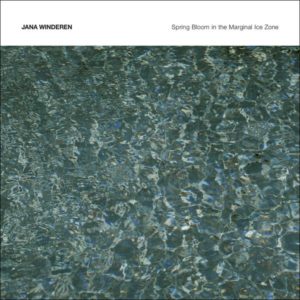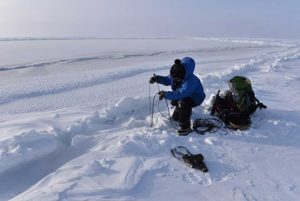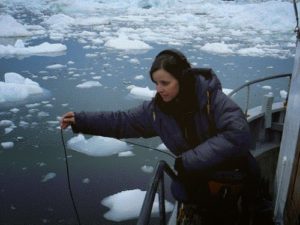Nearly everybody has a story to tell with „field recordings“, that will always trigger the knowledge about some of the most adventurous sounds being „out there“. Some of those albums became famous, some very much stayed under the radar (very much like the spaces they had been exploring). Even the so-called well-known can easily turn into stranger things. By chance, I once discovered an old album named „Trains in the Night“ beautifully capturing the sounds of old locomotives in England‘s vast hinterland, and the nature around. Listening to the compositions of artists like Jana Winderen or BJ Nilsen, is always a special experience. Is the howling of the wind real, or enhanced by electronics? How can someone „document“ sounds that cannot be be heard within our „normal“ range of perception? In a way the act of „cartographing“ distant areas includes sharpened senses, adequate tools – and inventiveness. When I was sinking, literally, into the „music“ of Jana‘s new record, I couldn‘t help but remember, in moments passing by, old sci-fi movies and books, but from minute to minute I was more and more drawn into the sounds themselves and forgetting my sepia-tinged nostalgia. Where-am-I-music of a rare kind.
Michael Engelbrecht: There is quite a spectrum of records that look for an “underwater experience” on the open sea, from the famous whale singing albums to the virtual / imagined feel of Gavin Bryars‘ „The Sinking of the Titanic“, from new age to neo-classical, field-recordings… Can you speak about your early listening experiences that were somehow related with a topic you would explore later in your life?
Jana Winderen: First of all, the experience of spending a lot of time alone in the forest when I was very young had profound influences on my relationship to listening and to what I am working on now. I also spent many hours with my grandfather out by the sea, and learned to appreciate and notice the smaller creatures and the ecosystems of which we are a part. Also the awareness of the algae overgrowth of the largest lake in Norway, Mjøsa, made a huge impression on me at an very early age. Later I decided to study to become a Marine biologist, though changed into visual art after 4 years and then later got into sound.
I met Mike Harding, one of the directors in Touch, about 15 years ago, and I remember he gave me a pile of CDs to listen to over the summer. I particularly loved listening to Philip Jeck, BJ Nilsen and Chris Watson, which all later became good friends and colleagues. Through the use of sensors and contact microphones I became aware of hydrophones, and started to listen inside ice, ants’ nests and trees, under the ice and deep in the ocean.
Listening and recording are preferably solo activities, since I need to concentrate and focus on finding the various species of fish and crustacea, and to listen to the variation in current, the distant roar of the water and to form a relationship with the environment. Lately I have also been recording with fishermen in the south of Thailand, who immediately start whispering when we turn off the engine, and do not send out stress vibes when we are recording for a long time – on the contrary suggesting to stay longer… I will go back and spend more time with them.
All these unheard sounds… generations of synthesizers have been striving for sound beyond the well-known. So, listening to your album, one is thinking from time to time: come on, this is at least shaped with electronic instruments… True or not?
I have never claimed that I am not processing some of the sounds, but I am not adding sounds originated from the computer or instruments. All the sound I use is originated from recordings I have done. The sounds of the creatures themselves, the different species of fish, crustacea, seals and whales I try to clarify and make as good, clear and audible as possible. I would never start to tune a fish for example.
But when I collage the sounds together, I would sometimes use the sound of rowing, the sound of wind and waves and stretch it in time and use some equalisation. There are also some manmade sounds in the compositions, like the seal-scarer audio device – it sounds like metal against metal. I included that since I want to talk about issues concerning the destructive use of these dangerous machines. I have included the sound of research ships, of military sonar and industrial sounds, even radio and morse signals I have recorded under water.
In recordings above our audible range, such as ultrasound, I slowed the recordings down, time-stretched them to make them audible to us; they will of course then sound very different than they do in the original frequency range, but it is to show us that there is also sound outside the reach of our perception, both above and below our capability of listening where other creatures are operating.
I think the recordings at the Barents Sea were not located to a single place or clearly defined frame of time. That said, you had to make artistic choices for the arrangement of the collected recordings. Is this the point were the composer takes over?
Sometimes I have been strictly using only sounds recorded from a particular river, or a particular glacier or site, for example ‚The Listener‘, which is from recordings from the River Orne in Normandy, or the piece I did for the project ‘Rivers’ at the AV festival in Newcastle; ‚Spawning Ground – from Coquet Head to the North Sea’ or ‚Rats – Byens hemmelige lydlandskap’ for Muchmuseet on the Move/Ny Musikk in Oslo – all related to particular places and recorded there. Other pieces are more imaginary travels but with recordings relating to that story, for example ‚The Wanderer‘, ‚Energy Field‘ or ‘Ultrafield‘. But they are based around a theme or an issue I wish to focus on and bring into the light. ‘Spring Bloom in the Marginal Ice Zone’ is recorded mostly in the Barents Sea and Arctic regions and the creatures you find there. The Bearded Seal´s hauling sound is recorded right there under the Sea-ice in the Barents Sea.
I would say that already out in the field when pushing record the composition process has already started; you make choices when you place the microphone or hydrophones, or ultrasound detectors in a certain place and start listening long before you record anything. Ideas start to form at this early stage. Its all down to the choices you make; even if you choose to leave the recording gear out by itself in the field, where you place it is a compositional choice.
I‘m quite sure you have seen BLUE PLANET 2, with the narrator David Attenborough and you have listened to the way Hans Zimmer has soundtracked the underwater scenery in the second episode, I think it had the title “The Deep Blue“. Too much “Hollywood“ in the score?
I wish that it had been more based around the very rich soundscapes you find underwater. Not just from all the crustacea, fish and mammals, but also of the distant waves, the movement of the water far out at sea – it sounds fantastic, when you are really listening. What sounds like there is nothing at first, after concentrated listening, move to several positions, listening at many different depths, you will experience so much variety. And it will never sound the same. It would have been great if they dared to use this material, instead of composing with instruments from very different environments, like violin, brass and piano recorded in air. And what’s the point of talking specialised sound recordists at great expensive out into these places if you then drown their work with ‘music’?
There has been quite a development between the days of Cousteau and modern day technology to dive into the depths of the ocean. Working on this project, were there dangerous moments? Or what has been your state of mind while working so far out. From early expeditions to arctic regions to science fiction movies, angst, utter loneliness can be part of the trip. Is it more fitting to bring a clear scientific mind into play and leave behind the “Jules Verne-state of mind”?
I do not tend to feel lonely when out in the field, i feel at home and calm. There had been incidences, like when I lost the car key in a far away lake in a National Park, and it dropped a meter into the mud, and my mobile phone was locked inside the car, or when I realised I was far to close to an icefjord and risked being washed away any time or when I recorded too close to an avalanche on top of a glacier; I knew I was risking too much to get a good recording… that was stupid.
Usually I am with local people who know the environment or on expeditions where there is a very competent crew, so I would say more dangerous situations have been closer to home in the local forest when I have fallen into mud holes, or stepped through the ice, with only my dog accompanying me. But I learned from experiences at an early age to respect the forces of nature; I remember the struggle of walking on skis downhill in a snow storm to reach our cabin, or be out alone on a windsurfing board when suddenly the wind stopped and it started to thunder and I had a metal mast, or being stuck in a cabin for 4 days because of the wind. It is part of growing up. I guess I carry this with me.
When working on Spring Bloom project my trip to the North Pole was quite scary though. Most of all because the people around me were so drunk. It was not, in my mind, a place to be unfocused and drunk, when the sea ice could rip open right through the tent at any moment. You need to be alert and awake. Another time I remember being in a zodiac among the ice flow in the Barents sea, when the fog came in and we no longer could determine if there were hungry polar bears nearby. Later that day I saw seal intestines on an ice flow full of seagulls and a huge polar bear slowly leaving the area.
I remember once, in Panama by the way, in a tropical environment, when trying to record in the virgin forest and a huge wasp came towards me; I quickly moved my gear out of the way, and stupidly distracted by a swampy area, I failed to notice the freshly-made large crocodile foot and tail prints in the sand right where we stood. I am not used to reading signs in a tropical environment as I am more accustomed to colder climates.
You have been documenting a zone of the ocean where the climate change already does its work, not for the best of our future. Is there a split between the trained scientist who delivers a scientific document of a dramatically changing part of nature and the adventurous sound searcher who can easily be overwhelmed by the “strange beauty“?
In 2006 I first recorded a glacier, Vatnajøkul in Iceland and I became aware of the massive sounds they make constantly when moving. Right after I went to Greenland to listen to the moving Icebergs in the Icefjord Kangia by Ilulisat, these recordings later became part of the release ‘Energy Field’ [Touch, 2009]. ‘Spring Bloom in the Marginal Ice Zone’ [Touch, 2018] is from an installation commission I did for Sonic Acts in Amsterdam in 2017. It was a 6 channel installation outside of the Muziekgebou. It is concerned with the Sea Ice, and the importance of the Spring Bloom in the area which the Norwegian politicians like to call “the Ice Edge”. And they like to think it is moving north so oil drilling can start in those higher latitudes.
Both scientist and artist working in this field often have the same engaged involvements, we are just looking and listening from slightly different perspectives. Of course with my science background it doesn’t feel like a split at all; we are working in the same direction, hoping to engage and awaken curiosity and knowledge. By the way – I feel more at home in those environments than I do in the centre of a city, where I get much more overwhelmed. Outside in the field I feel much safer and at home. I will say that the effect of the climate change is also very apparent in the tropics. For example, it has become harder to predict the weather conditions. I recently spoke to a very experienced fisherman in south of Thailand who told me it was becoming harder and harder recently to trust old signs of weather changes. It is shifting much faster these days.
What has been the intention of the “headphone mix“? It‘s not Kunstkopf, but obviously seems to broaden the stereo panorama, kind of …
This piece was originally made for and mixed on a 6 channel installation outside, at Muziekgebou in Amsterdam, I was sitting outside for 4 days to make it work there, so to make it into a stereo mix also on lower resolution, became something very different. When I was talking to Mike Harding about developing the idea for album release, he came up with the idea of doing two different mixes, which seems to have been appreciated. Its so great collaborating with Touch in this way; I think its been a huge advantage in developing my career and opening up ideas and opportunities. So we decided to make two different versions in stereo; one is mixed on speakers and one is mixed on headphones. In some ways this was the most time-consuming part of the production process; it took a lot of work to get it right where we were both happy.
Jana Winderen‘s website: janawinderen.com


